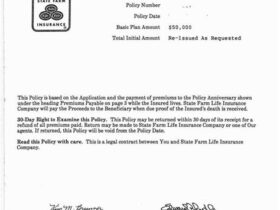Navigating the world of insurance can feel overwhelming, especially when dealing with unexpected events that lead to property damage, injury, or other losses. A key aspect of insurance involves understanding casualty claims – what they are, what they cover, and how to file them. This guide will break down the complexities of casualty claims, providing you with a clear understanding of the process and how it can help protect you financially.
What is a Casualty Claim?
A casualty claim is a formal request made to an insurance company for compensation following a loss or damage covered by a casualty insurance policy. Casualty insurance, in general, is a broad category encompassing various types of coverage designed to protect individuals and businesses from financial losses resulting from unforeseen events like accidents, injuries, negligence, or property damage. Unlike life insurance, which covers mortality, casualty insurance focuses on losses stemming from specific incidents.
The IRS also recognizes “casualty loss” which refers to damage to your home, furnishings, or vehicles. Claiming casualty loss on your tax return doesn’t result in dollar-for-dollar reimbursement, but it does lower your tax burden, which can mean more cash to help pay for recovery.
Types of Casualty Insurance Policies
Casualty insurance comprises various policies, each tailored to specific risks. Here are some common examples:
General Liability Insurance: This is one of the most common types of casualty insurance for businesses. It covers losses arising from accidents that cause injury or property damage to a third party. This includes protection against claims of bodily injury, personal injury, advertising injury, or property damage. For example, if a customer slips and falls in your store, general liability insurance can help cover the medical expenses and legal costs if you are sued.
Professional Liability Insurance (Errors and Omissions – E&O): This protects professionals like doctors, lawyers, accountants, and consultants against negligence claims made by clients. If a lawyer makes a mistake that costs their client money, E&O insurance can help cover the resulting damages.
Product Liability Insurance: This protects manufacturers, wholesalers, and retailers against financial losses resulting from a defective product that causes harm or damage. For example, if a toy manufacturer produces a toy with a design flaw that injures a child, product liability insurance can cover the resulting medical expenses and legal costs.
Commercial Auto Insurance: This covers vehicles used for business purposes, like company cars, work trucks, and fleet vehicles. It provides liability coverage in the event of an at-fault accident. This type of insurance is essential for businesses that rely on vehicles for their operations.
Workers’ Compensation Insurance: In most states, this is mandatory for employers. It covers workplace injuries and illnesses, providing wage replacement and medical benefits to employees injured on the job. This insurance protects both the employee and the employer from the financial burdens of workplace accidents.
What Does a Casualty Claim Cover?

The specific coverage of a casualty claim depends on the policy’s terms. However, casualty insurance policies typically cover the following:
Legal Costs: Casualty insurance helps pay for legal defense fees and court costs arising from covered claims. Legal representation can be expensive. Policies cover both the costs to defend against allegations as well as any lawyers required to handle the claim after a settlement.
Settlements and Judgments: If a lawsuit ends in a settlement or judgment against the insured, casualty insurance pays the amount owed to the claimant, up to the policy limits. This protects your assets from being seized.
Accidental Harm: Casualty insurance is designed to cover unintentional bodily injury or property damage that occurs due to negligence, mistakes, or accidents. However, policies usually do not cover intentional harm or damage.
Loss of Income: Some policies cover loss of income resulting from an accident or claim. For example, product liability insurance may cover lost profits if a defective product must be recalled.
Medical Expenses: If an accident results in injuries, the casualty policy typically pays the medical bills and rehabilitation costs of harmed third parties.
Wrongful Death: Fatalities that occur due to an accident may lead to wrongful death lawsuits. Casualty insurance can provide coverage against this type of claim.
Filing a Casualty Claim: A Step-by-Step Guide

Filing a casualty claim involves several steps. Here’s a general outline of the process:
Report the Incident: As soon as possible after the incident, report it to your insurance company. Provide them with all the relevant details, including the date, time, location, and a description of what happened. Sentry Casualty Company, for example, offers multiple channels for filing claims, including online, over the phone, and via mobile apps.
Document the Damage: Take photos and videos of any damage to property or injuries sustained. Gather any relevant documents, such as police reports, medical records, and repair estimates. According to the IRS, other steps include taking photographs of damaged property or belongings to document and calculate the amount of your loss; keeping receipts for associated expenses, including contracted work on property damaged by disaster; keeping records of the original value of any property, including a home, car, jewelry, or big credit card purchases.
File the Claim: Complete the claim form provided by your insurance company and submit it along with all supporting documentation. Be as accurate and detailed as possible.
Cooperate with the Adjuster: An insurance adjuster will be assigned to your claim to investigate the incident and assess the damages. Cooperate fully with the adjuster and provide them with any additional information they request.
Review the Settlement Offer: Once the adjuster has completed their investigation, they will provide you with a settlement offer. Review the offer carefully and make sure it adequately covers your losses. If you are not satisfied with the offer, you have the right to negotiate.
Seek Professional Help (If Needed): If you are having difficulty with the claims process or if you believe your insurance company is not treating you fairly, consider seeking assistance from a public adjuster or an attorney.
Important Considerations
Policy Limits and Deductibles: Be aware of your policy limits and deductibles. The policy limit is the maximum amount the insurance company will pay for a covered loss, while the deductible is the amount you must pay out of pocket before the insurance coverage kicks in.
Exclusions: Carefully review your policy exclusions, which are specific events or circumstances that are not covered by the policy.
Timely Filing: File your claim as soon as possible after the incident to avoid any potential issues with your insurance company.
Keep Records: Maintain detailed records of all communication with your insurance company, as well as any expenses related to the incident.
Casualty Claims and Disaster Relief

In the wake of a disaster, understanding casualty claims becomes even more critical. The IRS provides tax relief to individuals and businesses affected by federally declared disasters, including extensions to file taxes and the ability to write off certain losses.
If your area is declared a federal disaster site, you may qualify for an extension to file your taxes. The IRS maintains an official list online of all disaster locations that qualify you for an extension.
When dealing with disaster-related losses, remember to document everything. “We recommend saving media coverage,” said Flores. “If your neighborhood was on the news showing the disaster, write down what date that was or record that copy. Anything that substantiates your losses and what condition your property was in is helpful.”
Conclusion

Understanding casualty claims is crucial for protecting yourself and your assets from unexpected losses. By understanding the different types of casualty insurance policies, what they cover, and how to file a claim, you can navigate the insurance process with confidence and ensure you receive the compensation you deserve. Whether you’re a business owner seeking general liability coverage or an individual dealing with the aftermath of a natural disaster, knowing your rights and responsibilities regarding casualty claims is essential for financial security.





Leave a Reply